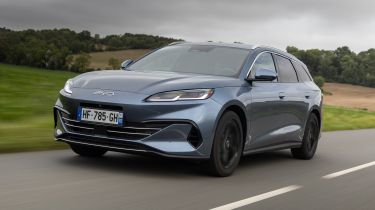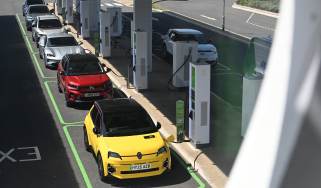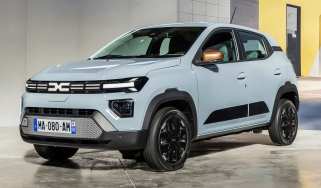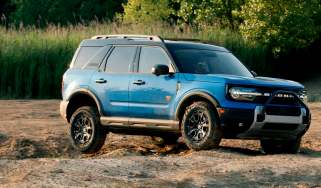New BYD Seal 6 Touring 2025 review: talented estate should have BMW worried
BYD’s latest estate isn’t an EV, but efficiency is still key

Verdict
A new car that’s neither an SUV or an EV? It’s a rarity in the current market, but the BYD Seal 6 Touring has plenty going for it beyond being a bit different. Unlike many plug-in hybrids, the 6 Touring’s smooth, electric-biased PHEV powertrain is designed to be efficient regardless of battery charge, and not simply a Benefit-in-Kind tax box-ticking exercise. But there’s plenty else for company car buyers to like; there’s loads of standard kit, a comfortable drive and plenty of cabin space. Once the very promising prices are set in stone and we've driven the car on UK roads there's potential for this already strong score to creep even higher.
This is the BYD Seal 6 DM-i Touring, a car which manages to buck the trend of the new car market in not just one, but two key ways.
The first is perhaps a surprising one from the biggest EV brand in the world, because the Seal 6 DM-i shows that BYD hasn’t fully turned its back on the internal combustion engine. It dabbles in plug-in hybrids, too.
In fact, ‘dabbles’ might be underselling it, somewhat. Its one PHEV offering so far to the UK market, the Seal U DM-i SUV, has surpassed 10,000 sales in 10 months, making it the most popular model in the brand’s lineup here.
Used - available now

2021 DS
DS 3 CROSSBACK E-TENSE
23,935 milesAutomaticElectric
Cash £11,697
2020 Nissan
Qashqai
43,911 milesManualPetrol1.3L
Cash £11,497
2021 Renault
Captur
33,241 milesManualPetrol1.0L
Cash £11,397
2017 Mazda
CX-3
33,111 milesManualPetrol2.0L
Cash £11,197The second, and most welcome, break from the norm is that the 6 Touring goes against the glut of SUVs that continues to grow by the week on the UK market thanks to its saloon and estate forms. Focus is firmly on the latter here - BYD has taken a leaf from BMW’s book and refers to its estate offering as ‘Touring’ - because it’s the one which is predicted to make up the bulk of UK sales.
While the Seal 6 Touring isn’t on sale in the UK just yet, our Buy a Car service has plenty of great BYD deals available right now. You can also find plenty of temptingly-priced used BYD models.
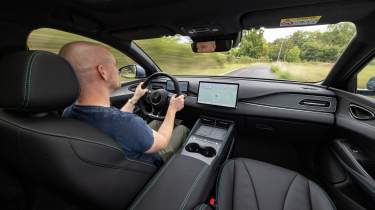
But look beyond the somewhat anodyne exterior of the 6 Touring and it’s what BYD boldly calls its ‘Super Hybrid’ powertrain, which is much more interesting. Looking at the specs of the petrol engine, some buyers might be a little underwhelmed at first. The Seal 6 DM-i’s 1.5-litre four-cylinder petrol produces a modest 98bhp and 122Nm of torque. Yes, it boasts a thermal efficiency of 43 per cent - up there with the best production engines around - but those aren’t exactly mind-blowing figures for even a modern supermini.
But that’s a blessing in disguise, because it means that it’s the electric motors that are doing the heavy lifting here.
In Boost trim, the Seal 6 Touring offers up 181bhp, whether operating as a full EV or as a hybrid, and charge is topped up by a 10kWh battery for an EV range of 31 miles in the Touring estate model. Above the Boost, the Comfort Lite and Comfort trims get a 19kWh battery, increasing the range to 62 miles in the estate - and three miles more for the saloon. These two trims get a little more power to offset the extra weight of the 100kg battery - 209bhp and 300Nm in total.
Given that those maximum outputs of both trims are available when the car is in full EV mode, it shows that the motors are playing a much larger part than the petrol engine. And it’s this electric-only mode which is how the system operates most of the time. When the battery energy runs low - or the driver overrides the system by prodding the HEV button on the dash - the engine acts like a generator to top up the battery. When full power is needed, both petrol and electric power sources work together to give maximum shove.
And that shove is fine, if not outstanding. A 0-62mph time of 8.5 seconds is nothing mind-blowing, but it moves the 6 Touring along the road nicely enough. The one minor blot on the powertrain is that, when the petrol engine is required to help out at the wheels, there is a noticeable pause before all the necessary systems can agree what to do.
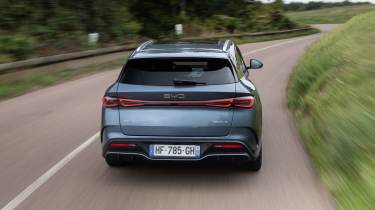
But that flaw only really presents itself if you need to mash the accelerator. Otherwise, the transition between petrol and electric is pretty much imperceptible; there’s so little vibration from the four-cylinder unit that the only real clue is a distant hum coming from somewhere up front. Indeed, it’s quiet enough that at motorway speeds you’ll hardly hear it at all - though that’s also partly because wind noise is a little on the strong side.
Rustling A-pillars aside, the Seal 6 Touring is a really competent cruiser. Comfort and stability are both great. A slightly sticky feel to the steering around the straight-ahead - a sensation that’s found in quite a few BYD models - is the main thing I take issue with. Like the wind noise, it’s a minor complaint, rather than a deal-breaker.
Our test was conducted on French roads which for the most part felt much smoother than the quality of typical British asphalt. So while I’ll fully reserve judgement on comfort until I get hold of one in the UK, first impressions suggest that the overall setup manages to strike a decent compromise between comfort and body control; it’s not overly firm, nor is it soft and wallowy through the turns. Bumps made their presence felt at low speeds, but the ride never felt harsh or unpleasantly thumpy on rough sections.
Much like the ride, it’s best to hold off on a conclusive verdict on efficiency until the car arrives in the UK, but there’s certainly some promise here. A mix of driving at motorway speeds - and that’s French motorway speeds of 80mph rather than 70mph - I managed to get 45 miles out of the battery before the petrol engine kicked in, and that was also with four people and their luggage on board. A return trip, with a depleted battery and again with four occupants, delivered an indicated economy of 51.4mpg. Both figures look very promising for PHEV buyers.
Inside, the Seal 6 Touring is largely similar to the rest of the BYD range, the dashboard layout is smooth, flowing, and dominated by a huge touchscreen. The Boost and our Comfort Lite test car get a 12.8 inch display; I can’t really see much need to go for the Comfort’s vast 15.6-inch screen. BYD has also ditched the rather gimmicky electrical rotating setup for the screen that features in all of its other models. Physical controls are lacking, but three-finger swipes vertically or horizontally on the screen adjust the temperature and fan speed respectively, which works well in practice.
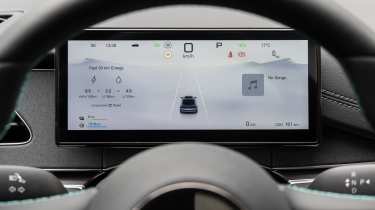
The quality of the materials is okay; not quite on the level of a Volkswagen Passat, but the fake leather and soft touch trims on the dash feel nice enough, even if the plastics around the centre console don’t quite feel up to the same standard.
Hop into the back and passengers are treated to acres of kneeroom. That ability to stretch out in front offsets the fact that headroom is merely okay, and the low seat base relative to the floor means that under-thigh support isn’t the best I’ve come across. A 500-litre boot is competitive for an estate with a PHEV powertrain.
Much like the rest of BYD’s family, standard equipment levels are far from meagre. The Boost gets metallic paint, LED headlights, 17-inch alloy wheels, electric front seats, rear parking sensors and a reversing camera. Touring versions also get a powered tailgate.
The Comfort ups the ante further, beginning with larger wheels and touchscreen - rising to 15.6 and 18 inches respectively, It also adds a heated steering wheel, puddle lights, rear privacy glass and 50kW wireless smartphone charging.
A host of safety systems are available, and the bonging from each of them is a constant reminder. Like other BYDs I’ve tried, the driver attention warning is the most irritating of the lot - even a deliberate look into the rear-view mirror can make the system throw a tantrum. Fortunately, it can be switched off.
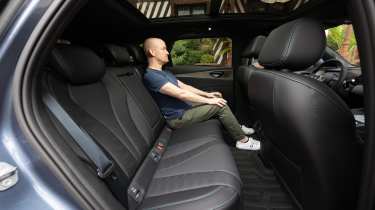
So how does all of this compare to the competition? Well on paper, the most obvious rival to the Seal 6 DM-i Touring is the Volkswagen Passat eHybrid. VW’s PHEV offering is very slightly longer and its boot is slightly larger at 510 litres. Its performance and EV range are also up at 201bhp (enough for an 8.1-second 0-62mph time - less for the 268bhp option) and there’s up to 82 miles of EV range. Of course, unlike the Passat, the BYD is available in both saloon and estate body styles.
BYD is yet to confirm prices for the UK market, but it's safe to say that it's going to cost quite a bit more than the eyebrow-raising £14,000 or so that it costs in China, where reports suggest that a price war among local manufacturers is getting a little out of hand. Still, figures here are shaping up to be very competitive relative to the alternatives.
The Boost is expected to start from around £33,000, with the top spec Comfort Touring (estate models are expected to cost around £2,000 more than the saloons) climbing towards £38,000. That looks promising beside the Volkswagen Passat, which starts from £43,800 and climbs beyond £50,000 in its top spec.
| Model: | BYD Seal 6 DM-i Comfort Lite Touring |
| Price: | £37,000 (est.) |
| Powertrain: | 1.5-litre 4cyl petrol, 1x e-motor, 19kWh battery |
| Power/torque: | 209bhp/300Nm |
| Transmission: | eCVT auto, front-wheel drive |
| 0-62mph: | 8.5 seconds |
| Top speed: | 112mph |
| Economy/CO2: | 58.9mpg/34g/km |
| Size (L/W/H): | 4,840/1,875/1,495mm |
| On sale: | January 2026 |

